Physics - Ch 66 Ch 4 Quantum Mechanics: Schrodinger Eqn (78 of 92) The Barrier: Amplitude
TLDRThis lecture delves into quantum mechanics, focusing on calculating the amplitude of a particle oscillating after passing through a barrier. It introduces the transmission coefficient, derived from the energy of the particle, the potential and width of the barrier. The lecture simplifies the equation for large barrier widths, showing how the transmission coefficient exponentially decreases with increasing barrier size, directly affecting the amplitude on the other side. Examples and further derivations are promised in upcoming videos.
Takeaways
- 📐 The amplitude of a particle passing through a barrier depends on the particle's energy, the barrier's potential, and the barrier's width.
- 🌐 The calculation focuses on the amplitude of oscillations in Region 3 compared to Region 1.
- 🔄 Region 1 has two terms in its equation accounting for particles moving forward and reflected by the barrier.
- 🚶♂️ Region 3 has one term, as particles only move in one direction after passing the barrier.
- 🔢 The transmission coefficient (T) is the ratio of the squared amplitude in Region 3 to the squared amplitude in Region 1.
- 🎢 The equation for the transmission coefficient is derived from the hyperbolic sine of alpha times L, where alpha is a constant and L is the barrier width.
- 📉 The transmission coefficient decreases exponentially as the barrier width (L) increases.
- 📶 A smaller transmission coefficient indicates a smaller amplitude on the other side of the barrier.
- 🌟 The simplification of the transmission coefficient equation is applicable when alpha times L is significantly larger than one.
- 📈 The script provides a foundation for calculating and understanding particle behavior in quantum mechanics scenarios.
- 🔍 Upcoming videos will delve into the derivation of these equations and provide examples of their application.
Q & A
What is the main topic of the lecture?
-The main topic of the lecture is the calculation of the amplitude of a particle passing through a barrier and the oscillations in the subsequent region.
What factors influence the amplitude of a particle after passing through a barrier?
-The energy of the particle, the potential of the barrier, and the width of the barrier are the main factors influencing the amplitude.
How is the amplitude in Region three related to the amplitude in Region one?
-The amplitude in Region three is related to the amplitude in Region one through the transmission coefficient, which is the ratio of their squared amplitudes.
What does the transmission coefficient (T) represent in this context?
-The transmission coefficient (T) represents the probability of a particle passing through the barrier and continuing to oscillate in Region three.
How does the transmission coefficient (T) change with an increase in the width (L) of the barrier?
-The transmission coefficient (T) decays exponentially as the width (L) of the barrier increases, indicating a smaller amplitude on the other side of the barrier.
What is the significance of the term 'hyperbolic sine of alpha times L' in the equation for the transmission coefficient?
-The term 'hyperbolic sine of alpha times L' is part of the equation that describes the relationship between the transmission coefficient and the barrier parameters, simplifying to a more manageable form when alpha times L is large.
What happens when alpha times L becomes large relative to one?
-When alpha times L becomes large relative to one, the equation for the transmission coefficient simplifies, allowing for an approximate calculation of T.
What is the role of the momentum of the particle in the transmission coefficient equation?
-The momentum of the particle is part of the ratio used in the denominator of the transmission coefficient equation, influencing the value of T.
How can one determine when to use the simplified version of the transmission coefficient equation?
-The simplified version of the transmission coefficient equation can be used when alpha times L is significantly larger than one, such as five or ten.
What will be covered in the upcoming videos?
-The upcoming videos will provide more details on the derivation of the equations, examples of their application, and the differences between the simplified and full versions of the transmission coefficient equation.
Outlines
🌟 Quantum Barrier Penetration and Amplitude Analysis
This paragraph introduces the concept of quantum barrier penetration, focusing on the amplitude of a particle passing through a barrier. It discusses how the amplitude is influenced by the energy of the particle, the potential of the barrier, and the barrier's width. The main goal is to calculate the oscillation amplitude in Region 3 compared to Region 1. The Shrödinger equation is introduced for describing the two regions, with terms for reflected and transmitted particles. The transmission coefficient (T) is defined as the ratio of the amplitudes in Region 3 to Region 1, and its calculation is based on a complex equation involving the hyperbolic sine of alpha times L, where alpha and L are specific parameters related to the barrier. The paragraph also touches on the simplification of the transmission coefficient equation when alpha times L is large, and how the coefficient decays exponentially with increasing L, indicating a smaller amplitude on the other side of the barrier.
Mindmap
Keywords
💡Amplitude
💡Particle
💡Barrier
💡Transmission Coefficient
💡Hyperbolic Sine
💡Energy
💡Potential
💡Width of the Barrier
💡Quantum Tunneling
💡Momentum
Highlights
The lecture focuses on calculating the amplitude of a particle passing through a barrier.
The amplitude depends on the energy of the particle, the potential of the barrier, and the width of the barrier.
The aim is to compare the amplitude of oscillations in Region 3 to that in Region 1.
Region 1 has two terms in its equation due to the possibility of particle reflection.
Region 3 has only one term as there's no reflection after passing the barrier.
The transmission coefficient is the ratio of the square of the amplitude in Region 3 to that in Region 1.
The amplitude in Region 3 is the square root of T times the amplitude in Region 1.
The transmission coefficient is defined by a complex equation involving hyperbolic sine and other factors.
The equation for the transmission coefficient is 1 divided by (1 plus hyperbolic sine of alpha times L).
Alpha is defined by the energy of the particle and the potential of the barrier.
The transmission coefficient simplifies when alpha times L is much larger than one.
The coefficient decays exponentially as L becomes large, indicating a smaller amplitude.
A smaller transmission coefficient corresponds to a smaller amplitude on the other side of the barrier.
The lecture will provide examples and details on calculating these values in future videos.
The derivation of the transmission coefficient equation will be covered in upcoming content.
The current content provides equations to calculate amplitude on one side of the barrier relative to the other.
Given energy (e), potential (V), and barrier width (L), one can calculate the amplitude ratio.
Transcripts
Browse More Related Video
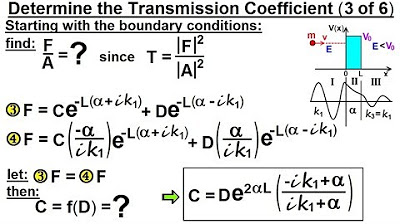
Physics - Ch 66 Ch 4 Quantum Mechanics: Schrodinger Eqn (85 of 92) Transmission Coeff=? (3 of 6)

Physics - Ch 66 Ch 4 Quantum Mechanics: Schrodinger Eqn (77 of 92) The Barrier: An Overview
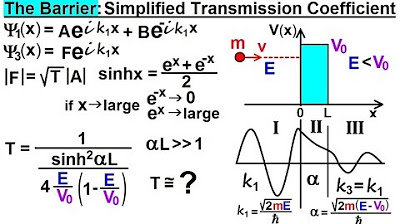
Physics - Ch 66 Ch 4 Quantum Mechanics: Schrodinger Eqn (79 of 92) Simplified Transmission Coeff.
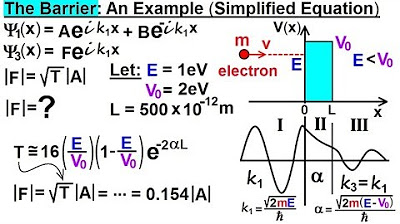
Physics - Ch 66 Ch 4 Quantum Mechanics: Schrodinger Eqn (80 of 92) Transmission Coeff. Example
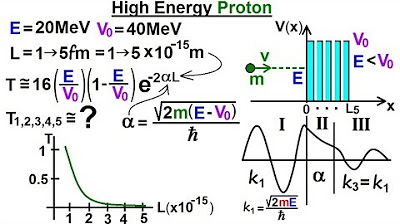
Physics - Ch 66 Ch 4 Quantum Mechanics: Schrodinger Eqn (90 of 92) A High Energy Proton
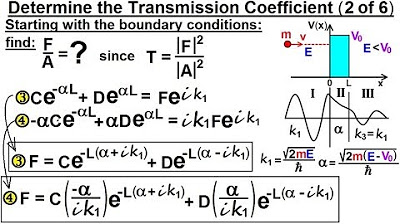
Physics - Ch 66 Ch 4 Quantum Mechanics: Schrodinger Eqn (84 of 92) Transmission Coeff=? (2 of 6)
5.0 / 5 (0 votes)
Thanks for rating: